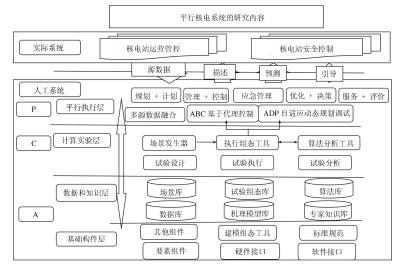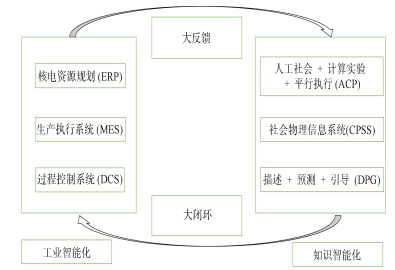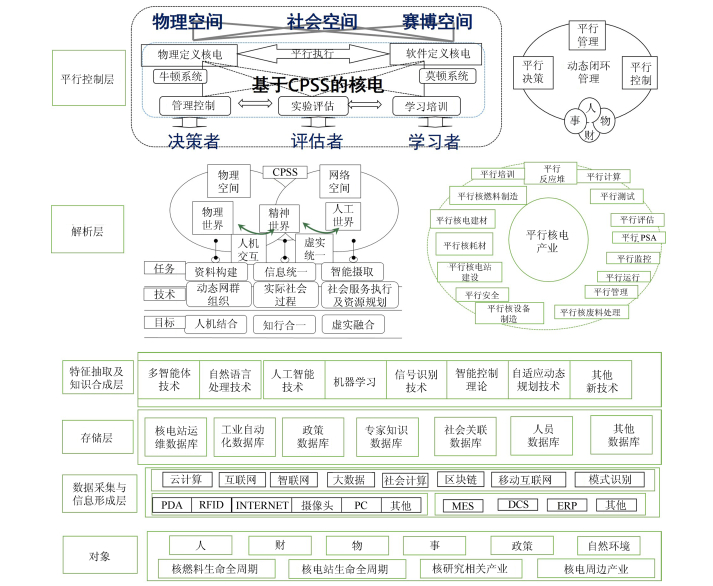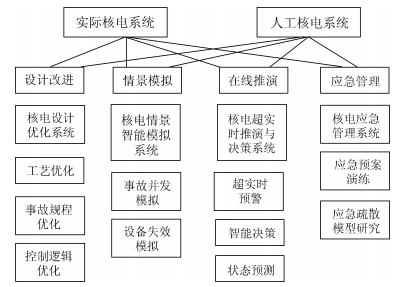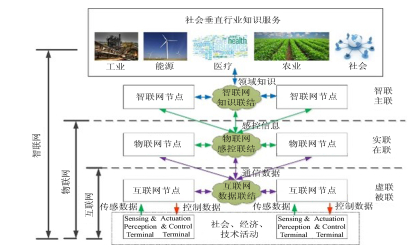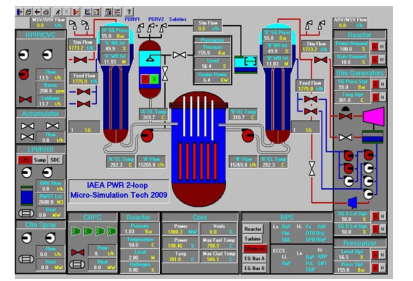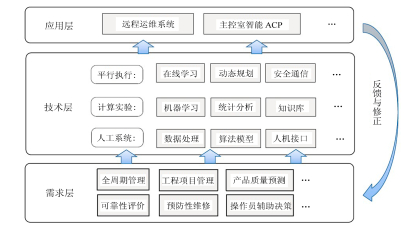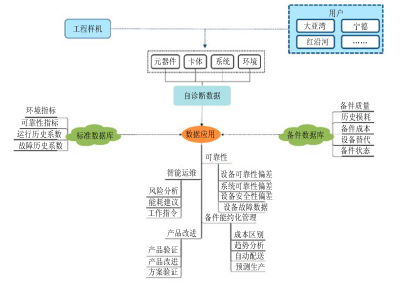|
[1]
|
张廷克, 李闽榕, 潘启龙.中国核能发展报告(2018).北京:社会科学文献出版社, 2018.
|
|
[2]
|
卡尔·波普尔.客观知识:一个进化论的研究.上海:上海译文出版社, 1972.Popper K R. Objective Knowledge:An Evolutionary Approach. Shanghai:Shanghai Translation Publishing House, 1972.
|
|
[3]
|
Jaspers K. The Origin and Goal of History. Munich:Piper Verlag GmbH, 1949.
|
|
[4]
|
库尔特·哥德尔. 〈数学原理〉及有关系统中的形式不可判定命题. 1931.Gödel K. On Formally Undecidable Propositions of Principia Mathematica and Related Systems(Ⅰ). 1931.
|
|
[5]
|
王飞跃.软件定义的系统与知识自动化:从牛顿到默顿的平行升华.自动化学报, 2015, 41(1):1-8 http://www.aas.net.cn/CN/abstract/abstract18578.shtmlWang Fei-Yue. Software-defined systems and knowledge automation:a parallel paradigm shift from Newton to Merton. Acta Automatica Sinica, 2015, 41(1):1-8 http://www.aas.net.cn/CN/abstract/abstract18578.shtml
|
|
[6]
|
Wang F Y. The emergence of intelligent enterprises:from CPS to CPSS. IEEE Intelligent Systems, 2010, 25(4):85-88 doi: 10.1109/MIS.2010.104
|
|
[7]
|
王飞跃, 杨坚, 韩双双, 杨柳青, 程翔.基于平行系统理论的平行网络架构.指挥与控制学报, 2016, 2(1):71-77 https://www.researchgate.net/profile/Fei_Yue_Wang/publication/317328968_The_Framework_of_Parallel_Network_Based_on_the_Parallel_System_Theory/links/5932737845851553b6aabedf/The-Framework-of-Parallel-Network-Based-on-the-Parallel-System-Theory.pdfWang Fei-Yue, Yang Jian, Han Shuang-Shuang, Yang Liu-Qing, Cheng Xiang. The framework of parallel network based on the parallel system theory. Journal of Command and Control, 2016, 2(1):71-77 https://www.researchgate.net/profile/Fei_Yue_Wang/publication/317328968_The_Framework_of_Parallel_Network_Based_on_the_Parallel_System_Theory/links/5932737845851553b6aabedf/The-Framework-of-Parallel-Network-Based-on-the-Parallel-System-Theory.pdf
|
|
[8]
|
王飞跃. X5. 0: 平行时代的平行智能体系. 新时代智能论坛, 2015. https://www.researchgate.net/publication/317328952_X50pingxingshidaidepingxingzhinengtixiWANG Fei-Yue. X5. 0: Parallel Intelligence System in Parallel ERA. The New Intelligence Age Forum. 2015. https://www.researchgate.net/publication/317328952_X50pingxingshidaidepingxingzhinengtixi
|
|
[9]
|
王飞跃.平行系统方法与复杂系统的管理和控制.控制与决策, 2004, 19(5):485-489 http://mall.cnki.net/magazine/Article/KZYC200405001.htmWang Fei-Yue. Parallel system methods for management and control of complex systems. Control and Decision, 2004, 19(5):485-489 http://mall.cnki.net/magazine/Article/KZYC200405001.htm
|
|
[10]
|
王飞跃.平行控制:数据驱动的计算控制方法.自动化学报, 2013, 39(4):293-302 http://www.aas.net.cn/CN/abstract/abstract17915.shtmlWang Fei-Yue. Parallel control:a method for data-driven and computational control. Acta Automatica Sinica, 2013, 39(4):293-302 http://www.aas.net.cn/CN/abstract/abstract17915.shtml
|
|
[11]
|
宁滨, 王飞跃, 董海荣, 文丁.高速铁路平行控制与管理系统研究框架.复杂系统与复杂性科学, 2010, 7(4):11-21 http://www.wanfangdata.com.cn/details/detail.do?_type=perio&id=fzxtyfzxkx201004002Ning Bin, Wang Fei-yue, Dong Hai-rong, Wen Ding. Framework of parallel control and management for high-speed railway systems. Complex Systems And Complexity Science, 2010, 7(4):11-21 http://www.wanfangdata.com.cn/details/detail.do?_type=perio&id=fzxtyfzxkx201004002
|
|
[12]
|
Glaessgen E H, Stargel D S. The digital twin paradigm for future NASA and U. S. air force vehicles. In: Proceedings of the 53rd AIAA/ASME/ASCE/AHS/ASC Structures, Structural Dynamics and Materials Conference. Honolulu, Hawaii, USA: AIAA, 2012. doi: 10.2514/6.2012-1818
|
|
[13]
|
Weber A. GE 'predix' the future of manufacturing. Assembly, 2017, 60(3):GE70-GE76 https://www.ptc.com/en/news/2016/ptc-and-ge-digital-to-expand-strategic-alliance
|
|
[14]
|
熊刚, 董西松, 王兆魁, 王飞跃. 平行控制与管理的研究及应用进展综述. 中国空天安全会议, 2017 http://cpfd.cnki.com.cn/Article/CPFDTOTAL-ZHKT201708001090.htmXiong Gang, Dong Xi-Song, Wang Zhao-Kui, Wang Fei-Yue. Research and Application Review of Parallel Control and Management. Chinese Aerospace Safety Symposium, 2017 http://cpfd.cnki.com.cn/Article/CPFDTOTAL-ZHKT201708001090.htm
|
|
[15]
|
王飞跃. 复杂系统的控制与管理机制研究及其应用. 见: 中国科学院院长基金特别支持项目立项书. 北京, 2005.Wang Fei-Yue. New mechanisms for control and management of complex systems: research and development. In: Project to the Presidents Foundation for Special Projects, Chinese Academy of Sciences. Beijing, China, 2005.
|
|
[16]
|
Wang F Y, Wang X, Li L X, Li L. Steps toward parallel intelligence. IEEE/CAA Journal of Automatica Sinica, 2016, 3(4):345-348 doi: 10.1109/JAS.2016.7510067
|
|
[17]
|
李力, 林懿伦, 曹东璞, 郑南宁, 王飞跃.平行学习——机器学习的一个新型理论框架.自动化学报, 2017, 43(1):1-8 http://www.aas.net.cn/CN/abstract/abstract18984.shtmlLi Li, Lin Yi-Lun, Cao Dong-Pu, Zheng Nan-Ning, Wang Fei-Yue. Parallel learning:a new framework for machine learning. Acta Automatica Sinica, 2017, 43(1):1-8 http://www.aas.net.cn/CN/abstract/abstract18984.shtml
|
|
[18]
|
Wang F Y, Zhang J, Wei Q L, Zheng X H, Li L. PDP:parallel dynamic programming. IEEE/CAA Journal of Automatica Sinica, 2017, 4(1):1-5 doi: 10.1109/JAS.2017.7510310
|
|
[19]
|
王飞跃, 王晓, 袁勇, 王涛, 林懿伦.社会计算与计算社会:智慧社会的基础与必然.科学通报, 2015, 60(5-6):460-469 http://mall.cnki.net/magazine/Article/KXTB2015Z1008.htmWang Fei-Yue, Wang Xiao, Yuan Yong, Wang Tao, Lin Yi-Lun. Social computing and computational societies:the foundation and consequence of smart societies. Chinese Science Bulletin, 2015, 60(5-6):460-469 http://mall.cnki.net/magazine/Article/KXTB2015Z1008.htm
|
|
[20]
|
Wang F Y, Wong P K. Intelligent systems and technology for integrative and predictive medicine:an ACP approach. ACM Transactions on Intelligent Systems and Technology, 2013, 4(2):Article No.32 http://europepmc.org/abstract/med/24883228
|
|
[21]
|
Wang F Y. Toward a paradigm shift in social computing:the ACP approach. IEEE Intelligent Systems, 2007, 22(5):65-67 doi: 10.1109/MIS.2007.4338496
|
|
[22]
|
Wang F Y. Parallel control and management for intelligent transportation systems:concepts, architectures, and applications. IEEE Transactions on Intelligent Transportation Systems, 2010, 11(3):630-638 doi: 10.1109/TITS.2010.2060218
|
|
[23]
|
王飞跃, 李晓晨, 毛文吉, 王涛.社会计算的基本方法与应用.杭州:浙江大学出版社, 2012.Wang Fei-Yue, Li Xiao-Chen, Mao Wen-Ji, Wang Tao. Social Computing:Methods and Applications. Hangzhou:Zhejiang University Press, 2012.
|
|
[24]
|
王飞跃. 社会能源与平行能源系统: 迈向能源5. 0的时代. 见: 分布式能源专业委员会筹备会及IEEE ITSS北京分会. 北京: 北方工业大学, 2015.Wang Fei-Yue. Social energy and parallel energy systems: towards the age of energy 5. 0. In: Workshop on Distributed Energy Systems and Annual Symposium of IEEE ITSS Beijing Chapter. Beijing, China: North China University of Technology, 2015.
|
|
[25]
|
王飞跃, 赵杰, 伦淑娴.人工电力系统与复杂大电网的运营和管理.南方电网技术, 2008, 2(3):1-6 http://www.cqvip.com/QK/88821X/200803/27981370.htmlWang Fei-Yue, Zhao Jie, Lun Shu-Xian. Artificial power systems for the operation and management of complex power grids. Southern Power System Technology, 2008, 2(3):1-6 http://www.cqvip.com/QK/88821X/200803/27981370.html
|
|
[26]
|
赵俊华, 文福拴, 薛禹胜, 董朝阳.电力信息物理融合系统的建模分析与控制研究框架.电力系统自动化, 2011, 35(16):1-8 http://mall.cnki.net/magazine/Article/DLXT201116000.htmZhao Jun-Hua, Wen Fu-Shuan, Xue Yu-Sheng, Dong Zhao-Yang. Modeling analysis and control research framework of cyber physical power systems. Automation of Electric Power Systems, 2011, 35(16):1-8 http://mall.cnki.net/magazine/Article/DLXT201116000.htm
|
|
[27]
|
赵俊华, 文福拴, 薛禹胜, 李雪, 董朝阳.电力CPS的架构及其实现技术与挑战.电力系统自动化, 2010, 34(16):1-7 http://mall.cnki.net/magazine/article/DLXT201016000.htmZhao Jun-Hua, Wen Fu-Shuan, Xue Yu-Sheng, Li Xue, Dong Zhao-Yang. Cyber physical power systems:architecture, implementation techniques and challenges. Automation of Electric Power Systems, 2010, 34(16):1-7 http://mall.cnki.net/magazine/article/DLXT201016000.htm
|
|
[28]
|
Ilic M D, Xie L, Khan U A, Moura J M F. Modeling of future cyber-physical energy systems for distributed sensing and control. IEEE Transactions on Systems, Man, and Cybernetics. Part A:Systems and Humans, 2010, 40(4):825-838 doi: 10.1109/TSMCA.2010.2048026
|
|
[29]
|
Xie L, Ilic M D. Module-based modeling of cyber-physical power systems. In: Proceedings of the 28th International Conference on Distributed Computing Systems Workshops. Beijing, China: IEEE, 2008. 513-518 http://dl.acm.org/citation.cfm?id=1439719
|
|
[30]
|
McMillin B. Complexities of information security in cyber-physical power systems. In: Proceedings of the 2009 IEEE/PES Power Systems Conference and Exposition. Seattle, WA, USA: IEEE, 2009. 1-2 http://ieeexplore.ieee.org/document/4840093/
|
|
[31]
|
Singh C, Sprintson A. Reliability assurance of cyber-physical power systems. In: Proceedings of the 2010 IEEE Power and Energy Society General Meeting. Minneapolis, MN, USA: IEEE, 2010. 1-6 http://www.researchgate.net/publication/224179251_Reliability_assurance_of_cyber-physical_power_systems
|
|
[32]
|
邓建玲, 王飞跃, 陈耀斌, 赵向阳.从工业4.0到能源5.0:智能能源系统的概念、内涵及体系框架.自动化学报, 2015, 41(12):2003-2016 http://www.aas.net.cn/CN/abstract/abstract18774.shtmlDeng Jian-Ling, Wang Fei-Yue, Chen Yao-Bin, Zhao Xiang-Yang. From industries 4.0 to energy 5.0:concept and framework of intelligent energy systems. Acta Automatica Sinica, 2015, 41(12):2003-2016 http://www.aas.net.cn/CN/abstract/abstract18774.shtml
|
|
[33]
|
王飞跃.指控5.0:平行时代的智能指挥与控制体系.指挥与控制学报, 2015, 1(1):107-120 http://www.wanfangdata.com.cn/details/detail.do?_type=perio&id=zhykzxb201501018Wang Fei-Yue. CC 5.0:intelligent command and control systems in the parallel age. Journal of Command and Control, 2015, 1(1):107-120 http://www.wanfangdata.com.cn/details/detail.do?_type=perio&id=zhykzxb201501018
|
|
[34]
|
江泽民.对中国能源问题的思考.上海交通大学学报, 2008, 42(3):345-359 http://mall.cnki.net/magazine/Article/SHJT200803002.htmJiang Ze-Min. Reflections on energy issues in China. Journal of Shanghai Jiaotong University, 2008, 42(3):345-359 http://mall.cnki.net/magazine/Article/SHJT200803002.htm
|
|
[35]
|
张力. 概率安全评价中人因可靠性分析技术研究[博士学位论文], 湖南大学, 中国, 2004 http://cdmd.cnki.com.cn/Article/CDMD-10532-2005040162.htmZhang Li. The Research on Human Reliability Analysis Technique in Probabilistic Safety Assessment[Ph. D. dissertation], Hu'nan University, China, 2004 http://cdmd.cnki.com.cn/Article/CDMD-10532-2005040162.htm
|
|
[36]
|
薛禹胜, 肖世杰.综合防御高风险的小概率事件:对日本相继天灾引发大停电及核泄漏事件的思考.电力系统自动化, 2011, 35(8):1-11 http://industry.wanfangdata.com.cn/dl/Detail/Periodical?id=Periodical_dlxtzdh201108001Xue Yu-Sheng, Xiao Shi-Jie. Comprehensively defending high risk events with low probability. Automation of Electric Power Systems, 2011, 35(8):1-11 http://industry.wanfangdata.com.cn/dl/Detail/Periodical?id=Periodical_dlxtzdh201108001
|
|
[37]
|
荆春宁, 赵科, 张力友, 李辉, 王诚诚, 钱怡洁, 等. "华龙一号"的设计理念与总体技术特征.中国核电, 2017, 10(4):463-467 http://www.cqvip.com/QK/89379X/201302/46329432.htmlJing Chun-Ning, Zhao Ke, Zhang Li-You, Li Hui, Wang Cheng-Cheng, Qian Yi-Jie, et al. The design philosophy and general technical features of HPR1000. China Nuclear Power, 2017, 10(4):463-467 http://www.cqvip.com/QK/89379X/201302/46329432.html
|
|
[38]
|
朱正威, 王琼, 吕书鹏.多元主体风险感知与社会冲突差异性研究——基于Z核电项目的实证考察.公共管理学报, 2016, (2):97-106 http://www.cqvip.com/QK/87267X/201602/668566259.htmlZhu Zheng-Wei, Wang Qiong, Lv Shu-Peng. Research on differences of multiple stakeholders' risk perception and social conflict——Empirical investigation of Z nuclear power project. Journal of Public Management, 2016, (2):97-106 http://www.cqvip.com/QK/87267X/201602/668566259.html
|
|
[39]
|
李鹏程, 张力, 戴立操, 邹衍华, 青涛, 胡鸿等.核电厂数字化主控室操纵员的情景意识可靠性模型.系统工程理论与实践, 2016, 36(1):243-252 doi: 10.12011/1000-6788(2016)01-0243-10Li Peng-Cheng, Zhang Li, Dai Li-Cao, Zou Yan-Hua, Qing Tao, Hu Hong, et al. Operator's situation awareness reliability model in digital main control rooms of nuclear power plants. Systems Engineering——Theory and Practice, 2016, 36(1):243-252 doi: 10.12011/1000-6788(2016)01-0243-10
|
|
[40]
|
王晓磊, 吕大刚.核电厂地震概率风险评估研究综述.土木工程学报, 2016, 49(11):52-68 http://www.cnki.com.cn/Article/CJFDTotal-DEFE201206003.htmWang Xiao-Lei, Lv Da-Gang. Review of seismic probability risk assessment of nuclear power plants. China Civil Engineering Journal, 2016, 49(11):52-68 http://www.cnki.com.cn/Article/CJFDTotal-DEFE201206003.htm
|
|
[41]
|
苏罡.中国核能科技"三步走"发展战略的思考.科技导报, 2016, 34(15):33-41 http://blog.sciencenet.cn/blog-336909-1005353.htmlSu Gang. The "three steps development strategy" of China nuclear power science and technology. Science & Technology Review, 2016, 34(15):33-41 http://blog.sciencenet.cn/blog-336909-1005353.html
|
|
[42]
|
王飞跃, 张俊.智联网:概念、问题和平台.自动化学报, 2017, 43(12):2061-2070 http://www.aas.net.cn/CN/abstract/abstract19181.shtmlWang Fei-Yue, Zhang Jun. Internet of minds:the concept, issues and platforms. Acta Automatica Sinica, 2017, 43(12):2061-2070 http://www.aas.net.cn/CN/abstract/abstract19181.shtml
|
|
[43]
|
程乐峰, 余涛, 张孝顺, 殷林飞, 瞿凯平.信息-物理-社会融合的智慧能源调度机器人及其知识自动化:框架、技术与挑战.中国电机工程学报, 2018, 38(1):25-40 http://www.cnki.com.cn/Article/CJFDTotal-DLXT201415001.htmCheng Le-Feng, Yu Tao, Zhang Xiao-Shun, Yin Lin-Fei, Qu Kai-Ping. Cyber-physical-social systems based smart energy robotic dispatcher and its knowledge automation:framework, techniques and challenges. Proceedings of the CSEE, 2018, 38(1):25-40 http://www.cnki.com.cn/Article/CJFDTotal-DLXT201415001.htm
|
|
[44]
|
Wang F Y, Zhang J J, Wang X. Parallel intelligence:toward lifelong and eternal developmental AI and learning in cyber-physical-social spaces. Frontiers of Computer Science, 2018, 12(3):401-405 doi: 10.1007/s11704-018-7903-5
|
|
[45]
|
袁勇, 王飞跃.区块链技术发展现状与展望.自动化学报, 2016, 42(4):481-494 http://www.aas.net.cn/CN/abstract/abstract18837.shtmlYuan Yong, Wang Fei-Yue. Blockchain:the state of the art and future trends. Acta Automatica Sinica, 2016, 42(4):481-494 http://www.aas.net.cn/CN/abstract/abstract18837.shtml
|
|
[46]
|
袁勇, 周涛, 周傲英, 段永朝, 王飞跃.区块链技术:从数据智能到知识自动化.自动化学报, 2017, 43(9):1485-1490 http://www.aas.net.cn/CN/abstract/abstract19125.shtmlYuan Yong, Zhou Tao, Zhou Ao-Ying, Duan Yong-Chao, Wang Fei-Yue. Blockchain technology:from data intelligence to knowledge automation. Acta Automatica Sinica, 2017, 43(9):1485-1490 http://www.aas.net.cn/CN/abstract/abstract19125.shtml
|
|
[47]
|
袁勇, 王飞跃.平行区块链:概念、方法与内涵解析.自动化学报, 2017, 43(10):1703-1712 http://www.aas.net.cn/CN/abstract/abstract19148.shtmlYuan Yong, Wang Fei-Yue. Parallel blockchain:concept, methods and issues. Acta Automatica Sinica, 2017, 43(10):1703-1712 http://www.aas.net.cn/CN/abstract/abstract19148.shtml
|
|
[48]
|
麦克卢尔, 斯卡姆布智, 库尔茨[著], 钟向群[译]. 黑客大曝光. 北京: 清华大学出版社, 2010.McClure S, Scambray J, Kurtz G[Author], Zhong Xiang-Qun[Translator]. Hacking Exposed. Beijing: Tsinghua University Press, 2010.
|
|
[49]
|
王飞跃.计算实验方法与复杂系统行为分析和决策评估.系统仿真学报, 2015, 16(5):893-897 http://mall.cnki.net/magazine/Article/XTFZ200405008.htmWang Fei-Yue. Computational experiments for behavior analysis and decision evaluation of complex systems. Journal of System Simulation, 2015, 16(5):893-897 http://mall.cnki.net/magazine/Article/XTFZ200405008.htm
|
|
[50]
|
王飞跃, 邱晓刚, 曾大军, 曹志冬, 樊宗臣.基于平行系统的非常规突发事件计算实验平台研究.复杂系统与复杂性科学, 2010, 7(4):1-10 http://www.wanfangdata.com.cn/details/detail.do?_type=perio&id=fzxtyfzxkx201004001Wang Fei-Yue, Qiu Xiao-Gang, Zeng Da-Jun, Cao Zhi-Dong, Fan Zong-Chen. A computational experimental platform for emergency response based on parallel systems. Complex Systems and Complexity Science, 2010, 7(4):1-10 http://www.wanfangdata.com.cn/details/detail.do?_type=perio&id=fzxtyfzxkx201004001
|
|
[51]
|
崔凯楠, 郑晓龙, 文丁, 赵学亮.计算实验研究方法及应用.自动化学报, 2013, 39(1):1157-1169 http://www.aas.net.cn/CN/abstract/abstract18148.shtmlCui Kai-Nan, Zheng Xiao-Long, Wen Ding, Zhao Xue-Liang. Researches and applications of computational experiments. Acta Automatica Sinica, 2013, 39(1):1157-1169 http://www.aas.net.cn/CN/abstract/abstract18148.shtml
|
|
[52]
|
熊刚, 侯家琛, 刘胜, 张家麟, 付满昌.《控制科学与工程学科发展报告》专题报告"核电自动化".北京:中国科学技术出版社, 2011. 176-181Xiong Gang, Hou Jia-Chen, Liu Sheng, Zhang Jia-Lin, Fu Man-Chang. Chapter:Nuclear Power Automation, Report on Advances in Control Science and Engineering, Beijing:ChinaScience & Technology Press.2011. 176-181
|
|
[53]
|
Xiong G, Dong X S, Hou J C. Chapter 14:Construction of artificial power systems based on ACP approach. Service Science, Management, and Engineering. Oxford:Elsevier Press and Hangzhou:Zhejiang University Press, 2012.
|
|
[54]
|
王飞跃, 刘德荣, 熊刚, 程长建, 赵冬斌.复杂系统的平行控制理论及应用.复杂系统与复杂性科学, 2012, 9(3):1-12 http://mall.cnki.net/magazine/Article/FZXT201203002.htmWang Fei-Yue, Liu De-Rong, Xiong Gang, Cheng Chang-Jian, Zhao Dong-Bin. Parallel control theory of complex systems and applications. Complex Systems and Complexity Science, 2012, 9(3):1-12 http://mall.cnki.net/magazine/Article/FZXT201203002.htm
|
|
[55]
|
熊刚, 王飞跃, 侯家琛, 董西松, 张家麟, 付满昌.提高核电站安全可靠性的平行系统方法.系统工程理论与实践, 2012, 32(5):1018-1026 doi: 10.12011/1000-6788(2012)5-1018Gang Xiong, Wang Fei-Yue, Hou Jia-Chen, Dong Xi-Song, Zhang Jia-Lin, Fu Man-Chang. To improve safety and reliability of nuclear power plant with parallel system method. Systems Engineering-Theory and Practice, 2012, 32(5):1018-1026 doi: 10.12011/1000-6788(2012)5-1018
|
|
[56]
|
王丹, 白佳. "和睦系统":中国核电数字化仪控新名片——专访北京广利核系统工程有限公司总经理江国进.中国核电, 2017, 10(3):302-305 http://zghd.cbpt.cnki.net/WKD/WebPublication/wkTextContent.aspx?colType=4&yt=2017&st=03Wang Dan, Bai Jia. FirmSys:a new business card of China's digital I & C system for nuclear power plant——Special interview with JIANG Guojin, Director, China Techenergy Co., Ltd.. China Nuclear Power, 2017, 10(3):302-305 http://zghd.cbpt.cnki.net/WKD/WebPublication/wkTextContent.aspx?colType=4&yt=2017&st=03
|





 下载:
下载:
